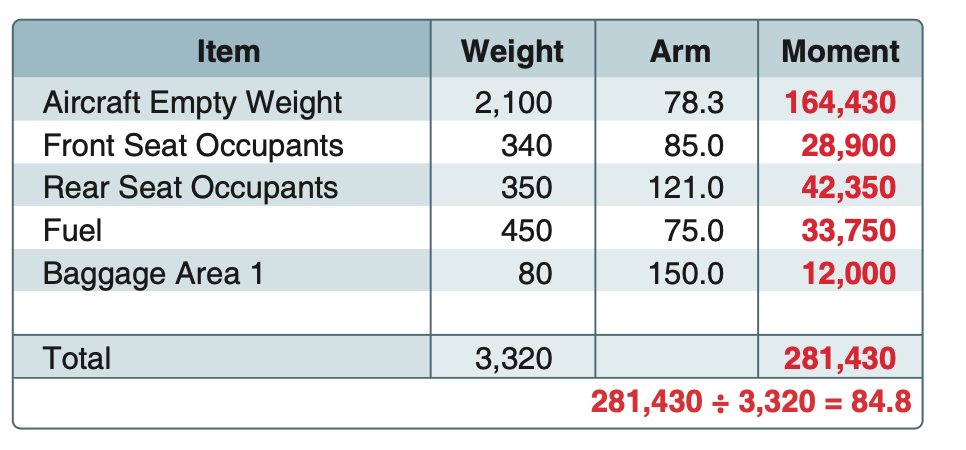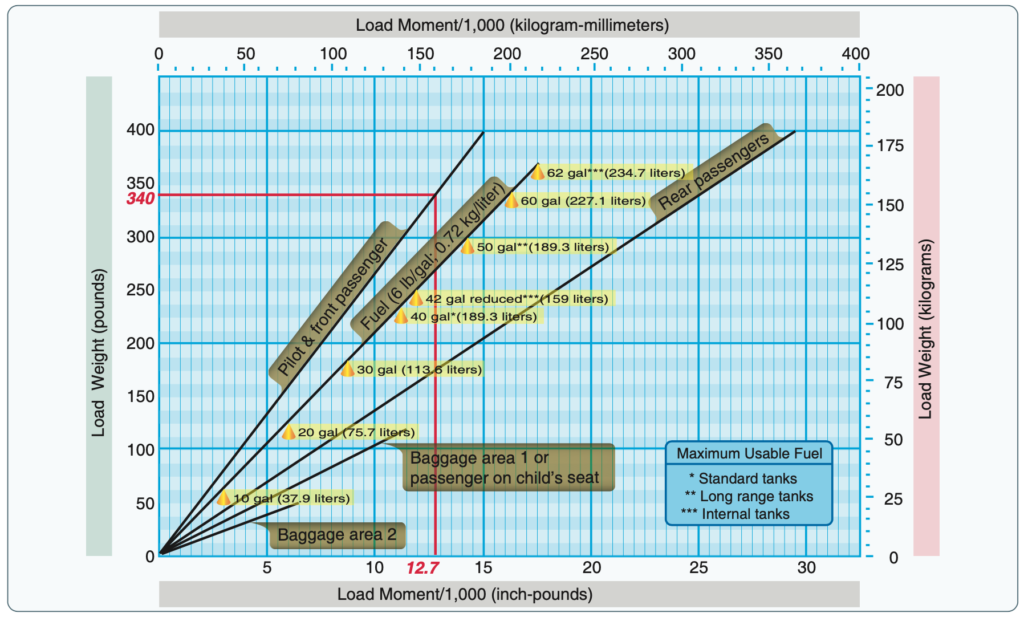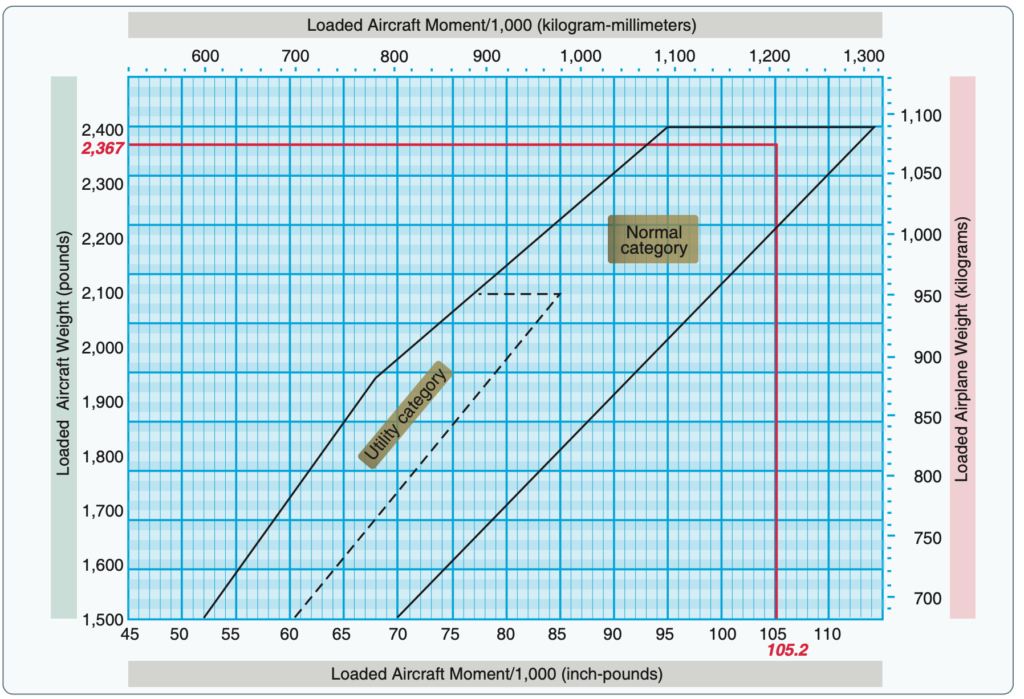Locating the CG
There are various methods for determining the loaded weight and CG of an aircraft. There is the computational method as well as methods that utilize graphs and tables provided by the aircraft manufacturer.
Definitions
The pilot should be familiar with the appropriate terms regarding weight and balance. The following list of terms and their definitions is standardized, and knowledge of these terms aids the pilot to better understand weight and balance calculations of any aircraft.
Arm (moment arm) – The horizontal distance in inches from the reference datum line to the CG of an item. The algebraic sign is plus (+) if measured aft of the datum and minus (–) if measured forward of the datum.
Basic empty weight – The standard empty weight plus the weight of optional and special equipment that have been installed.
Center of gravity (CG) – The point about which an aircraft would balance if it were possible to suspend it at that point. It is the mass center of the aircraft or the theoretical point at which the entire weight of the aircraft is assumed to be concentrated. It may be expressed in inches from the reference datum or in percent of MAC. The CG is a three-dimensional point with longitudinal, lateral, and vertical positioning in the aircraft.
CG limits – The specified forward and aft points within which the CG must be located during flight. These limits are indicated on pertinent aircraft specifications.
Delta – A Greek letter expressed by the symbol Δ to indicate a change of values. As an example, ΔCG indicates a change (or movement) of the CG.
Floor load limit – the maximum weight the floor can sustain per square inch/foot as provided by the manufacturer.
Fuel load – The expendable part of the load of the aircraft. It includes only usable fuel, not fuel required to fill the lines or that which remains trapped in the tank sumps.
Maximum landing weight – The greatest weight that an aircraft is normally allowed to have at landing.
Maximum ramp weight – The total weight of a loaded aircraft including all fuel. It is greater than the takeoff weight due to the fuel that will be burned during the taxi and run-up operations. Ramp weight may also be referred to as taxi weight.
Maximum takeoff weight – The maximum allowable weight for takeoff.
Maximum weight – The maximum authorized weight of the aircraft and all of its equipment.
Maximum zero fuel weight – The maximum weight, exclusive of usable fuel.
Mean aerodynamic chord (MAC) – The average distance from the leading edge to the trailing edge of the wing.
Moment – The product of the weight of an item multiplied by its arm. Moments are expressed in pound-inches (in-lb). Total moment is the weight of the airplane multiplied by the distance between the datum and the CG.
Station – A location in the aircraft that is identified by a number designating its distance in inches from the datum. The datum is, therefore, identified as station zero. An item located at station +50 would have an arm of 50 inches.
Useful load – The weight of the pilot, copilot, passengers, baggage, usable fuel, and drainable oil. It is the basic empty weight subtracted from the maximum allowable gross weight.
Computational Method
The following is an example of the computational method involving the application of basic math functions.
Aircraft Allowances:
- Maximum gross weight: 3,400 pounds
- CG range: 78–86 inches
Given:
- Weight of front seat occupants: 340 pounds
- Weight of rear seat occupants: 350 pounds
- Fuel: 75 gallons
- Weight of baggage in area 1: 80 pounds
- List the weight of the aircraft, occupants, fuel, and baggage. Remember that aviation gas (AVGAS) weighs 6 pounds per gallon and is used in this example.
- Enter the moment for each item listed. Remember “weight x arm = moment.”
- Find the total weight and total moment.
- To determine the CG, divide the total moment by the total weight.

NOTE: The weight and balance records for a particular aircraft provide the empty weight and moment, as well as the information on the arm distance.
The total loaded weight of 3,320 pounds does not exceed the maximum gross weight of 3,400 pounds, and the CG of 84.8 is within the 78–86 inch range; therefore, the aircraft is loaded within limits.
Graphical Method
Another method for determining the loaded weight and CG is the use of graphs provided by the manufacturers. To simplify calculations, the moment may sometimes be divided by 100, 1,000, or 10,000.
Given:
- Front seat occupants: 340 pounds
- Rear seat occupants: 300 pounds
- Fuel: 40 gallons
- Baggage area 1: 20 pounds
The same steps should be followed in the graph method as were used in the computational method except the graphs provided will calculate the moments and allow the pilot to determine if the aircraft is loaded within limits. To determine the moment using the loading graph, find the weight and draw a line straight across until it intercepts the item for which the moment is to be calculated. Then draw a line straight down to determine the moment. The red line on the loading graph in the figure below represents the moment for the pilot and front passenger. All other moments were determined the same way. Once this has been done for each item, total the weight and moments and draw a line for both weight and moment on the CG envelope graph. If the lines intersect within the envelope, the aircraft is loaded within limits. In this sample loading problem, the aircraft is loaded within limits.


